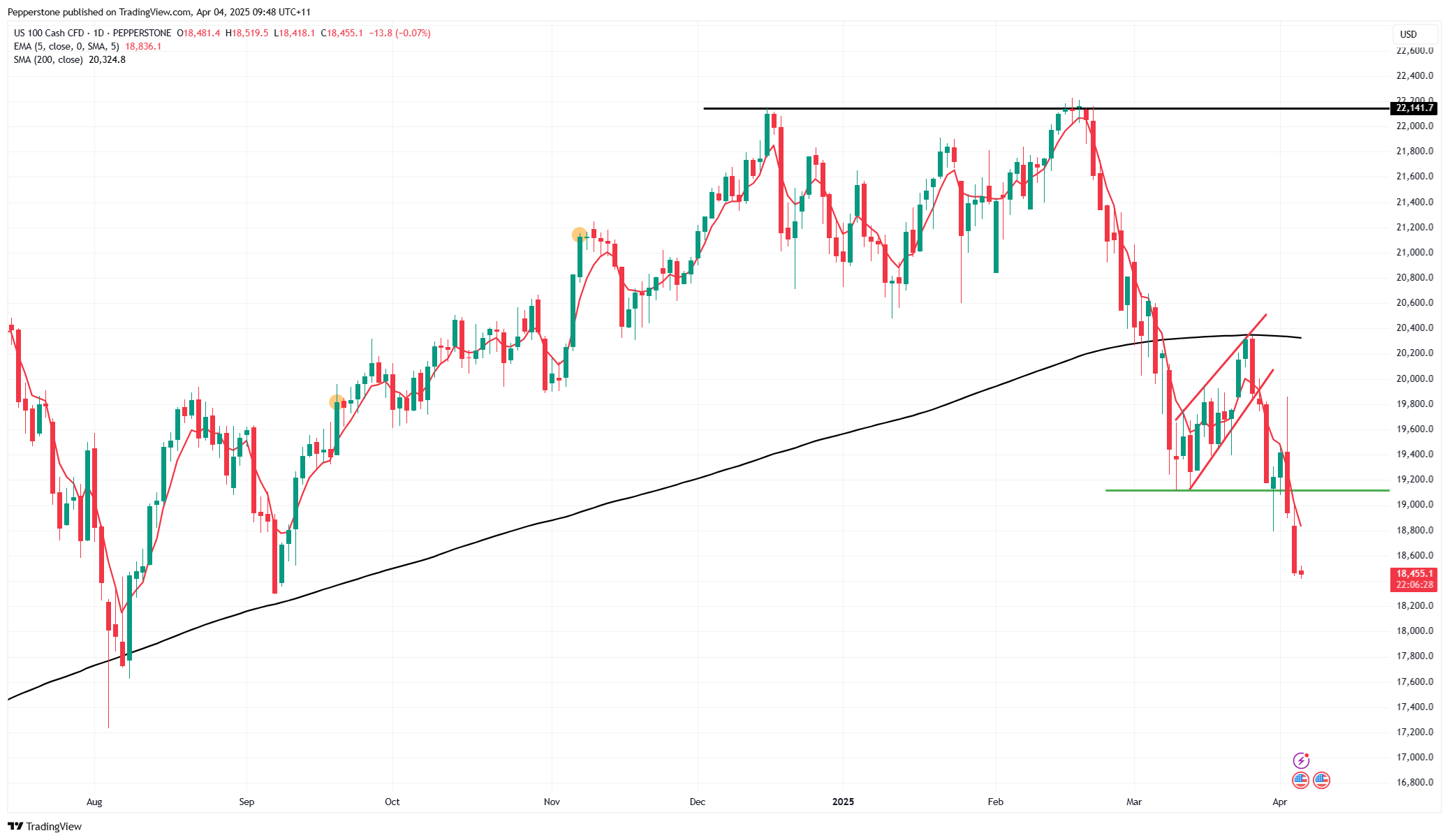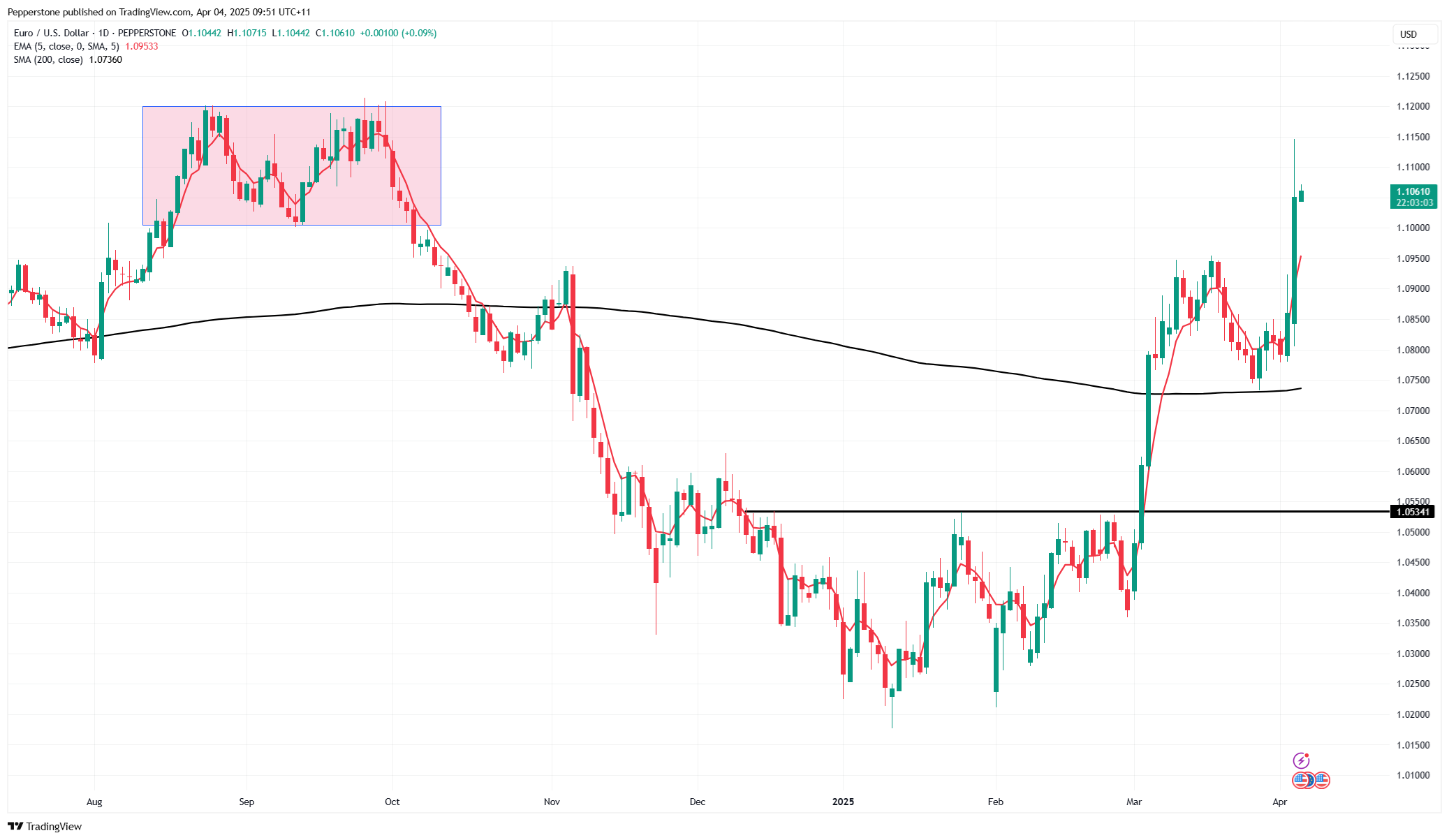Margin trading products are complex instruments and come with a high risk of losing money rapidly due to leverage. 88% of retail investor accounts lose money when trading on margin with this provider. You should consider whether you understand how margin trading works and whether you can afford to take the high risk of losing your money.
- English
Markets Break Down as Tariffs Bite, Uncertainty Reigns and Recession Odds Jump

“Uncertainty” is the word of 2025, and while we now have the tariff rates and the timeline, and Trump and Bessent have shown some willingness to negotiate, the questions being asked of the market have only increased.
We can start with the US Administration's logic in formulating the tariff rates by taking the trade deficit divided by the value of the US imports and charging at 50%. This logic has then been projected on each nation, to result in some incredibly high tariff rates on smaller nations which will have no positive effect on US economics but will severely impact these nations.
Expect a 10%+ Hit to S&P500 Earnings Expectations
We consider the hit to earnings, and we can assume equity strategists will start to take down S&P500 12-month EPS assumptions by 10%+. This puts the upcoming US Q125 earnings season (starting 11 April) squarely on the radar, with the market set to hang off every word company CEOs say about how they’re managing the tariff impact, and where one suspects the volatility and the daily percentage moves on reporting day in single stock names will hit record levels.
We consider whether tariffs will go anywhere close to achieving the set objectives: trade deficit reduction, raising revenue to offset tax cuts, bringing US production back to the US, and incentivising foreign firms to produce in the US. Of course, any internal success metrics won’t be realised for some time – potentially even years - and many are already thinking about the Administration’s game plan should the success metrics fail.
Eyeing US Inflation Expectations
The impact on US and global economics is key. On the day we’ve seen some wild moves playing out in US inflation markets, with US 1-year inflation swaps rising an impressive 29bp to 3.73% on the re-open, only to come crashing back to 3.45% shortly after – the wash-up is that short-term inflation measures have risen 8bp on the day to 3.48%, although the risk is that these now reverse lower.
Market-based measures of medium- and longer-term US inflation expectations (for example, US 5y5y inflation swaps) are probably the better gauge given the falls in commodity prices, and the message heard from the US Treasury market with US 2yr Treasures -18bp, and the Treasury yield curve aggressively bull steepening is one of lower demand that suggest downside risks further out to price pressures. The Fed will be watching broad financial conditions closely, but measures of medium- and longer-term inflation expectations will be front of mind, as this feeds into the notions of falling aggregate demand, reduced CEO confidence and capex intentions and lower consumption.
In US rates/swaps markets, the collective price Fed easing in June as a done deal, with four 25bp cuts now priced through to the end of the year. Terminal Fed pricing has been pulled to 3.17% with an additional 18bp of cuts implied added on the day through the full extent of the curve. Importantly, trough Fed pricing pulls ever closely to the Fed’s neutral rate of 3%, and this is significant as pricing below 3% loosely implies the Fed stepping out of a restrictive policy setting and into a more stimulatory setting.
We also continue to see clear deterioration in US high-yield credit, with spreads blowing out 27bp, with US equity casting an ever-closer sensitivity to moves in credit.
The pricing of US recession risk within 12 months has naturally risen, with the betting markets pushed to a 50% implied. Moves in commodity markets speak to this risk, with crude (-6.6%) and gasoline sold down hard. Cyclical areas of US equity have been chopped up, with retailers, small/regional US banks, and industrial names cut up, as have equity with a strong US brand that source high levels of revenue offshore – not only will global consumers increasingly look at alternative/non-US products and services, and refrain from ‘buying US made’ but corporates bringing production to the US is obviously not cheap and it takes time.
Market Moves on the Day

With US equity markets now closed, it’s hard to say the day was anything but ugly….. Both the S&P500 and NAS100 (cash and futures) closed on their respective lows, and while we did some rotate into the ultra-defensive areas of equity (S&P500 staples closed higher), this was an out-and-out liquidation of equity, with funds further de-risking, short selling activity markedly picking up and forced selling also having a hand.
The options market has also come alive, and this would have had a big hand in the moves in the underlying equity on the day, with over 1.3 million lots traded, equating in a massive $707b of notional (on the S&P500), where we’ve seen 7.2 puts traded to every call option.
Granted, US equity did attempt a rally intraday, but the sellers took over and worked the indices back lower. The fact that Trump detailed that the market reaction was “going well” perhaps a renewed trigger to get out of dodge, but it was a dark close, with all US indices having 4 to 5 z-score moves on the day, with volumes 50% above average. The technicals paint a worrying picture and this is a market where rallies will be frequent but constrained and traders will likely be quick to sell into pockets of strength. Subsequently, the path of least resistance is skewed lower, and with both implied and realised volatility rising, correlations (between equities) increasing and options dealers holding an increased short gamma exposure, the propensity for this high volatility regime to be sustained is elevated.
Carving up the USD

The loss of confidence to hold USDs is clear, and after a period of low vol in G10 FX, the USD has come alive with a trend, volume and with measures of implied vol rising sharply. Short USDCHF and USDJPY have been the plays on the day, with daily percentage changes of 2%+. EURUSD has attracted the lion’s share of client flows though, with a mix of momentum accounts trading from the long side, while others were better to sell on the moves above 1.1000 and above 1.1100. The question here is whether the USD sell-off can really kick and trend lower, similar to what we saw in November 2022 to January 2023. There is certainly the platform for a renewed USD bear trend to materialise, and while relative rate settings and growth are a key factor, as is the idea that Trump et al welcome this move, the big kicker is China and how they respond through the currency channels.
China has tended to hold out from announcing counter-measures until the new tariff rates have actually kicked in, so we may have to wait until 9 April before we see a more defined response, but if the USD can’t rally against the CNY (or CNH) even after such aggressive tariff rates, then the chances of a bear trend in the USD against G10 FX will only increase.
Navigating US Nonfarm Payrolls
With traders looking for further intel on how the tariffed nations counter, the focus also falls on the US nonfarm payrolls release in upcoming US trade. Again, the risk for the USD and US risk assets is pronounced and while we could see some relief on a solid jobs report, I’d again argue that given the environment we’re in, the USD, equity, crude and rates would have a far more pronounced move to a miss in the NFP print. Simplistically, any NFP print below 100k, with a higher unemployment rate (currently 4.1%) and especially if average hourly earnings didn’t follow suit, would only send risk down hard.
Good luck to all.
The material provided here has not been prepared in accordance with legal requirements designed to promote the independence of investment research and as such is considered to be a marketing communication. Whilst it is not subject to any prohibition on dealing ahead of the dissemination of investment research we will not seek to take any advantage before providing it to our clients.
Pepperstone doesn’t represent that the material provided here is accurate, current or complete, and therefore shouldn’t be relied upon as such. The information, whether from a third party or not, isn’t to be considered as a recommendation; or an offer to buy or sell; or the solicitation of an offer to buy or sell any security, financial product or instrument; or to participate in any particular trading strategy. It does not take into account readers’ financial situation or investment objectives. We advise any readers of this content to seek their own advice. Without the approval of Pepperstone, reproduction or redistribution of this information isn’t permitted.